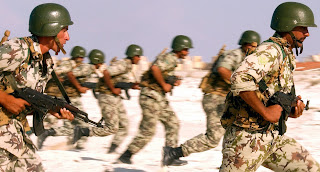The Global Fire Power ranking, or
GFP, measures countries’ military strength and assigns a power index number in
order to compare them to other countries. Many factors are taken into
consideration, and smaller countries can compete with larger ones due to points
given for refinement and technological advancement.
Just seven African countries are
ranked by the GFP. An inadequate amount of information is available to compare
other countries that are not included. Based on available information, the
following countries represent the most powerful militaries on the African continent
in 2013, according to GlobalFirepower.com.
1. Egypt – Power Index: 0.7569
Egypt is put over the top with
regard to military strength due to the sheer size of its armed forces. Nearly
500,000 personnel serve on its active frontline force, far surpassing all of
its African neighbors, as well as its nearly 10,000 armored fighting vehicles,
60,000 logistical vehicles, 900 aircraft, and large oil reserve from which to
draw. Again, the military has been somewhat undermined in the wake of the
Egyptian Revolution, but some argue that its increased role in government has
made it stronger than ever. Whether or not this is a cause for celebration or
concern will remain hotly debated for some time to come.
2. Ethiopia – Power Index: 1.1725
As a landlocked country, Ethiopia
has focused its resources on developing its army and air force to an impressive
degree (the GFP doesn’t penalize landlocked countries for not having a naval force).
Several hundred thousand personnel make up its current force, and they have
significant numbers of land and air systems at their disposal. Furthermore, an
enormous population that is fit for service allows Ethiopia to maintain the
capacity to turn out an even larger fighting force, and gives the country one
of the greatest militaries on the continent.
3. South Africa – Power Index: 1.2582
As it hasn’t been embroiled in an
international military conflict for some time, South Africa uses its highly
advanced military for more peacekeeping and international cooperation purposes.
Its aircraft and naval vessels are notoriously well-equipped with the latest
technology, and though the country has less than 100,000 active frontline
personnel, it has the capabilities and manpower for much more. Add to that a
vast array of land system technology, and the South African military is indeed
a force to be reckoned with.
4. Nigeria – Power Index: 1.3441
Due to its size, it’s no surprise
that several hundred thousand troops comprise the Nigerian Armed Forces,
through its army, navy, and air force. Like Algeria, an abundant domestic oil
supply eases the financial burden to be involved in military conflict, and it
has more than 1,400 armored vehicles, 360 tanks, and 6,000 logistical vehicles
at its disposal, as well as nearly 300 aircraft and 25 high-powered naval
vessels.
5. Algeria – Power Index: 1.4107
As Algeria has a large maritime
border, it has developed all of its military capabilities to an impressively
modern degree, including its land, sea, and air forces. Algeria’s active
frontline personnel numbers more than 127,000 troops and it has nearly 2,000
armored fighting vehicles at its disposal. Algeria also has the added benefit
of its own oil reserves, allowing it to use its own fuel to power tanks,
aircraft carriers, naval vessels, and more.
6. Kenya – Power Index: 1.6237
Kenya has established itself as a
vital participant in international peacekeeping missions, and is able to do so
due to a high merchant marine strength and an enormous labor force – resulting
in high available manpower. Though it doesn’t possess as much of its own
equipment, its role as a member of international teams allows the Kenyan
military to share resources with other countries, strengthening its own
capabilities at the same time.
7.
Libya – Power Index: 1.8428
The strength of Libya’s military
comes mainly from its large cache of equipment, despite a relatively small
number of active troops. Further hampering Libya’s abilities is the continuing
violence and unrest stemming from the revolution begun in 2011 which has yet to
see a stable government emerge from it. Regardless, the country still has
available 2,500 armored fighting vehicles, 500 tanks, 600 towed artillery
pieces, 6,500 logistical vehicles, and much more.






